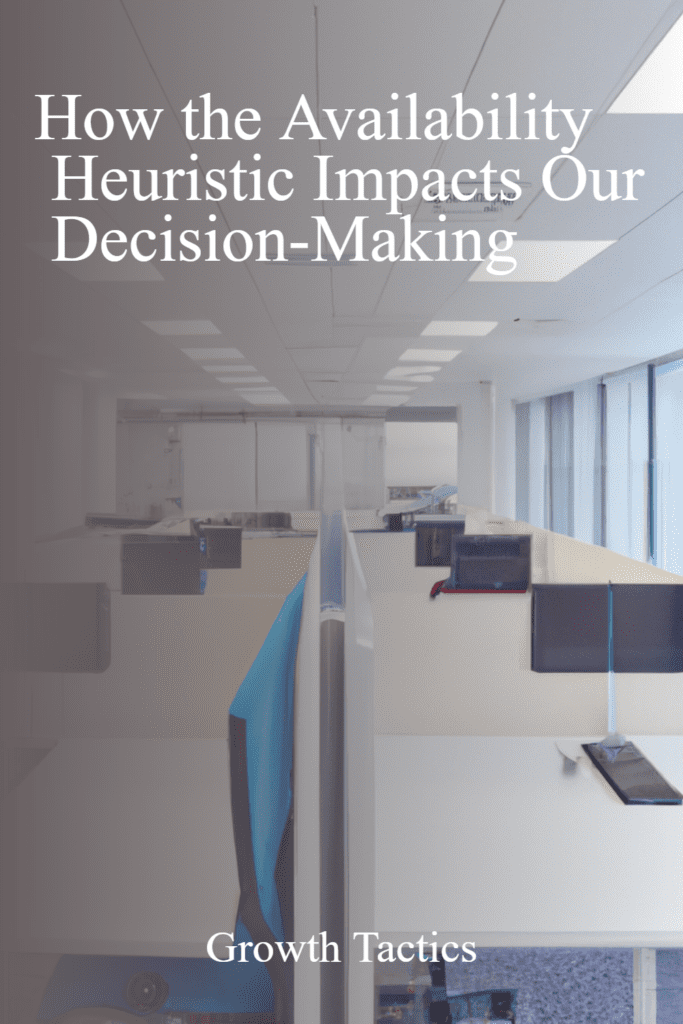Have you ever made a snap decision based on easily accessible information or a quick judgment without considering other factors? You may have been influenced by the availability heuristic, a mental shortcut that can affect how we make decisions. In this post, we’ll dive into the availability heuristic, heuristic bias, and how you can avoid falling into this cognitive trap.
What is the Availability Heuristic?
Have you ever wondered why our minds tend to latch onto certain information more readily than others? Well, it turns out that our brains have a little cognitive shortcut called the availability heuristic, and it has an interesting origin.
Our journey begins with the renowned psychologists Amos Tversky and Daniel Kahneman. In the 1970s, they started exploring the fascinating ways in which our minds deviate from rational thinking. One of the biases they discovered was the availability heuristic.
The availability heuristic is rooted in the idea that our judgments and decisions are often influenced by the ease with which relevant examples or information come to mind. In simpler terms, we tend to rely heavily on immediate and accessible information when making judgments or decisions, rather than considering a broader range of data.
Now, you may be wondering why our brains have evolved to use such a heuristic. Well, it all comes down to efficiency. Our minds are constantly bombarded with a vast amount of information, and processing all of it in a thorough and meticulous manner would simply be overwhelming. So, to simplify this complex task, our brains have developed shortcuts or heuristics to help us make quicker decisions. The availability heuristic is just one of many shortcuts our minds use to handle the information overload.
How Does the Availability Heuristic Work?
When we face a decision, our brains tend to rely on the information that is most easily accessible and omit other information that is not as available. This mental shortcut is based on the assumption that easily recalled information is more relevant or more important than other information. It’s a type of cognitive bias that can lead to overestimating the likelihood of an event because of its prevalence in our memory or the media.
The availability heuristic works by using the third letter of words that begin with a certain letter. For instance, if we are asked to name ten words that begin with the letter “s,” we are more likely to name words that come to mind quickly, such as “sun” or “sand,” rather than “saxophone” or “samurai.”
Examples of the Availability Heuristic
The availability heuristic can influence our decision-making in various aspects of life. Here are some examples that demonstrate how this cognitive bias can affect our choices:
Example 1: Assessing the Likelihood of an Event
Let’s say you want to decide whether or not to invest in the stock market. If you recently watched news stories reporting market crashes, it’s likely that those negative events will come to mind quickly. As a result, you may perceive the probability of a market crash as being higher than it actually is. This example showcases how the availability heuristic can lead to fear-based decision-making and potentially impact your investment choices.
Example 2: Health-Related Decisions
When considering medical treatment options, the availability heuristic can also come into play. Suppose you hear about a friend who had a negative experience with a particular medication. This information, being easily accessible in your memory, might influence your perception of the medication’s effectiveness or safety. Consequently, you may avoid using that medication based on the negative experience of someone you know, without considering the broader evidence or the experiences of others who had positive outcomes with it.
Example 3: Assessing the Likelihood of Success
Another common area where the availability heuristic can influence decision-making is in personal goal-setting. Let’s say you aspire to become a successful entrepreneur. If you frequently encounter success stories of entrepreneurs who made it big, these examples could create an availability bias in your mind. As a result, you might overestimate the odds of your own success, as the vivid and easily recalled examples skew your perception of the likelihood of achieving your goals.
Example 4: Travel Destination Selection
When choosing a travel destination, our perception of safety can be greatly influenced by the availability heuristic. If there have been recent news reports of a terrorist attack in a particular country, that information can become highly accessible in our memory. Consequently, we might avoid traveling to that country, even if statistically it remains a safe destination. This example illustrates how sensationalized news coverage can create a biased view of the risk associated with a specific location.
Example 5: Food Choices
Even our daily food choices can be affected by the availability heuristic. Suppose you are trying to decide between two restaurants for dinner. If you recently heard a negative review about one of the restaurants, that information may dominate your thinking and make it more easily recalled. As a result, you may be more likely to choose the other restaurant, even if there isn’t enough evidence to determine if it truly provides a better dining experience.
These examples demonstrate how the availability heuristic can impact our decision-making across various domains of life. By being aware of this cognitive bias, we can strive to make more rational and informed choices, taking into account a comprehensive set of information rather than relying solely on what is easily accessible in our memory.
Benefits & Pitfalls of the Availability Heuristic
While the availability heuristic can help us make quick decisions, it’s not foolproof. Here are some benefits and pitfalls to keep in mind.
Benefits
The availability heuristic can simplify complex decision-making processes, which can be especially useful in time-sensitive situations. For example, if you’re walking down a dark alley at night and hear footsteps approaching, your mind immediately jumps to the readily available information that might confirm your safety risks, like news reports of muggings or assaults that took place in that area. Thanks to the availability heuristic, your brain can quickly reach a conclusion without requiring much effort or analysis.
Additionally, recalling experiences or events that we’ve personally witnessed can help us empathize with others. After all, it’s easier to understand someone’s situation if you’ve been in a similar position yourself. Sharing these common experiences can help build relationships and strengthen social bonds.
Pitfalls
However, the availability heuristic can also lead to biased or erroneous decision-making. For example, if you regularly read sensationalist news reports about shark attacks while on vacation, you may be more likely to avoid the ocean—even though the actual risks of being attacked by a shark are quite low. This illustrates how the availability heuristic can cause us to overestimate the likelihood of certain events based on emotionally charged, highly accessible examples.
Similarly, relying solely on readily available information can lead to errors in judgment or decision-making. What’s more, the information that’s most readily available may not always be the most accurate or relevant to the situation at hand.
Lastly, the availability heuristic may cause us to dismiss relevant information that is less emotionally charged or memorable. This could cause us to overlook important data that’s necessary for making informed and well-rounded decisions.
In conclusion, the availability heuristic can be beneficial for quick decision-making, but it may also lead to flawed judgment. Recognizing the limitations and pitfalls of this heuristic can help us navigate complicated decision-making processes with greater accuracy and effectiveness. By being mindful of both its benefits and pitfalls, we can avoid biases and make more rational decisions.
Avoiding the Availability Heuristic
The availability heuristic is a cognitive bias that can influence our decision-making process. To mitigate the impact of this bias and make more objective decisions, there are several strategies you can employ:
1. Seek diverse sources of information
One way to avoid the availability heuristic is to seek out a wide range of information from diverse sources. This helps to counterbalance the information that comes to mind easily. By exposing yourself to different perspectives and sources, you can gain a more comprehensive understanding of a situation, reducing the influence of easily available but possibly biased information.
2. Engage in critical thinking
Developing critical thinking skills can help you challenge the information that comes to mind easily. Instead of accepting it at face value, critically evaluate the validity and reliability of the information. Consider the potential biases and limitations of your sources. This approach allows you to make more reasoned decisions based on a more objective assessment of the available information.
3. Look for data and evidence
When faced with a decision, try to look for empirical data and evidence that can provide a more accurate representation of the situation. This can help you move beyond personal anecdotes or easily recalled information and make decisions based on objective facts and statistics. Analyzing data and evidence can help you gain a clearer understanding of the probabilities and likelihoods involved, reducing the impact of the availability heuristic.
4. Take your time
Making decisions too quickly can make us more susceptible to the availability heuristic. By taking your time and giving careful consideration to all available information, you can reduce the influence of easily accessible but potentially biased thoughts. Slowing down the decision-making process allows you to explore different angles and perspectives, fostering a more balanced approach.
5. Keep a decision journal
Keeping a decision journal can help you reflect on past decisions and identify potential biases or patterns related to the availability heuristic. By recording the thought process behind your decisions, you can become more aware of the factors influencing your choices. This self-reflection can lead to greater mindfulness and help you develop habits that counteract the availability bias.
6. Consult others and encourage dissenting opinions
When making important decisions, seek input from others and encourage different perspectives. By considering a variety of viewpoints, you can challenge the influence of the availability heuristic. Discussing your thought process with others can provide valuable insights and help you uncover blind spots or biases that may be present in your own thinking.
7. Be aware of your emotions
Emotions can play a significant role in decision-making and can be influenced by the availability heuristic. Take the time to acknowledge and understand your emotions before making a decision. By separating your emotions from the decision-making process, you can make more objective choices.
8. Consider base rates
Base rates refer to the general statistical likelihood of an event occurring. Instead of relying solely on easily recalled instances, consider the broader data and probabilities associated with a particular decision. Understanding the base rates can help you avoid overestimating or underestimating the likelihood of an event.
9. Practice mindfulness
Cultivating mindfulness can help you become more aware of your thoughts and the potential biases influencing your decision-making. By being present in the moment and observing your thoughts without judgment, you can better recognize when the availability heuristic is at play.
10. Seek feedback
Asking for feedback from trusted individuals can provide valuable insights and alternative perspectives. Others may help you identify potential biases or challenge your assumptions, reducing the impact of the availability heuristic.
By implementing these strategies, you can reduce the impact of the availability heuristic and make more well-rounded, informed decisions. Being mindful of cognitive biases and actively working to counteract them can lead to more rational and objective decision-making in various aspects of your life.
Conclusion
In conclusion, the availability heuristic can have a powerful impact on our decision-making, leading us to overestimate the importance of easily accessible information and overlook broader data and probabilities. By being mindful of the availability heuristic and working to counteract its influence, we can make more well-rounded, informed decisions that are not limited by the biases of our own experiences and memories.


